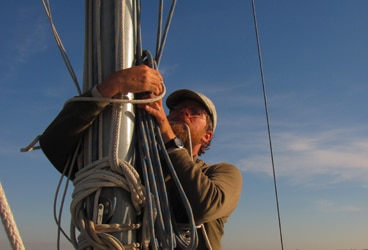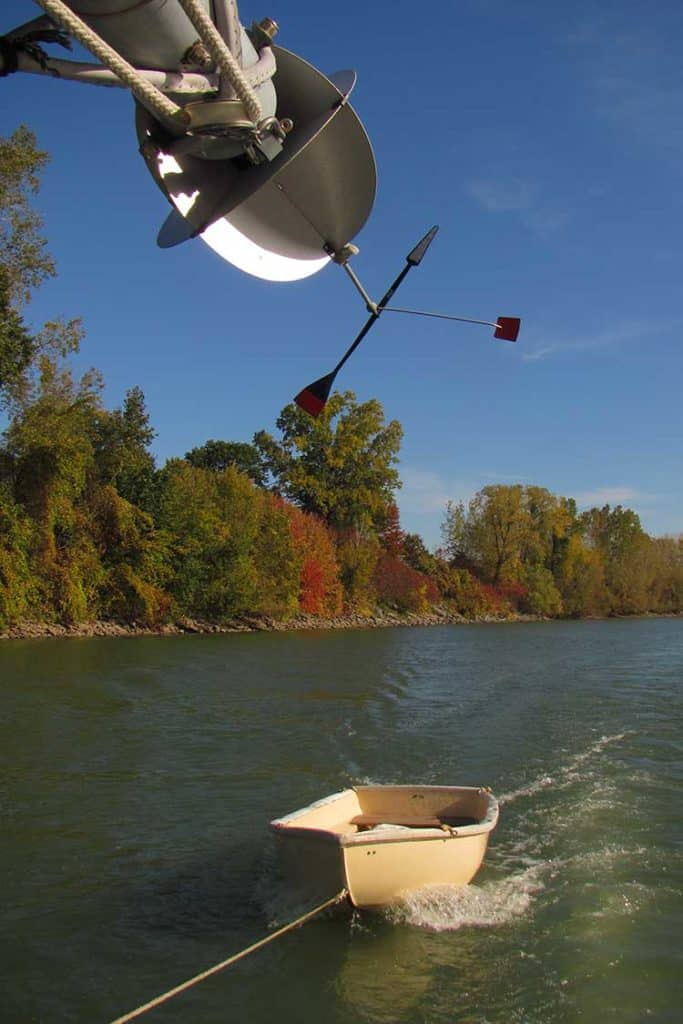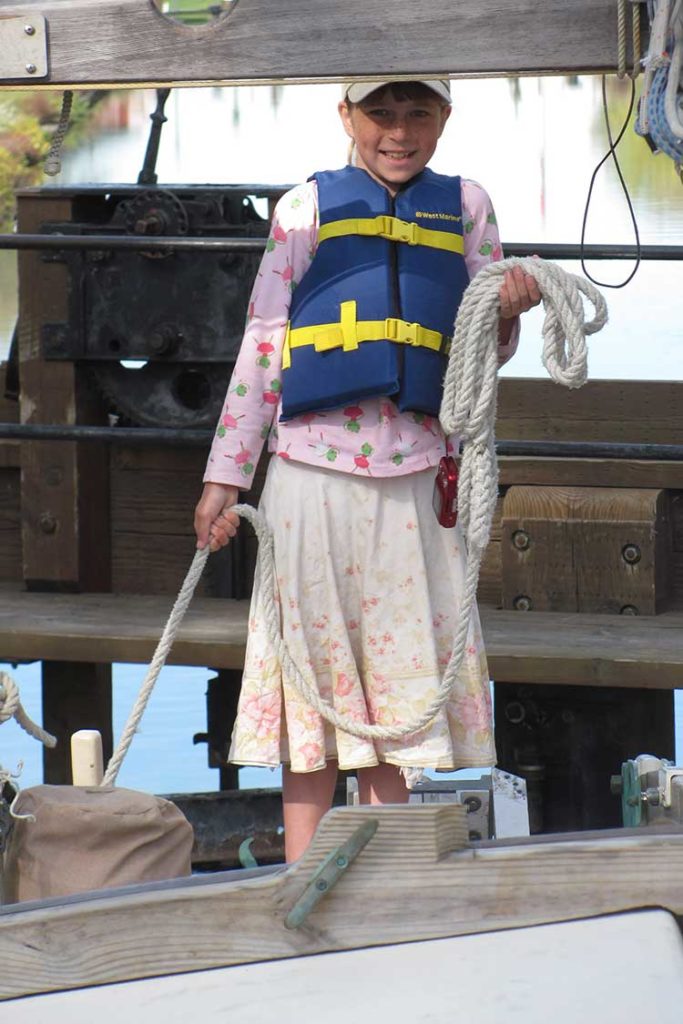
“No worries,” I had been telling everyone for the last month—everyone who had pointed out that to go through the Chambly Canal the mast would have to come down—“It’s mounted on a tabernacle; we can get it down at anchor, if we have to.”
Little known to us, we WOULD have to lower it at anchor—the two marinas in Sorel-Tracy, when we got up in the chilly dawn, appeared to be closed down. One of them was obviously getting dredged, and not a mast or a boat was to be seen over the breakwaters of the other one. There would not be a crane available if we wanted it. It was time to put our money where our mouths were. I hate that feeling.
With fingers that didn’t want to bend in the cold, I set about unshackling mast hoops, unreeving halyards, and de-rigging the sail. To save time, we just bundled the sail against the gaff without undoing the lacing and set it all on the side deck. Then came the tricky part. In the absence of several long 2x6s to make a sheer-legs out of, I had to use the boom as a crane. It’s a heavy one, built of thick fiberglass, and manhandling it out parallel to the bowsprit was no joke.
Then came the ticklish business of hoisting it vertical with the jaws braced on deck against the forehatch coaming. It took both of us, one heaving on a tackle and the other one steadying with guy ropes, but soon it was up and stayed down tight, like a mini-mast of it’s own. Unreeving the deadeye lanyards was the matter of only a few minutes, and with out hearts in our throats lest a container ship should make a wake at an inconvenient time, we pulled the locking pin on the tabernacle and lowered gingerly away.

It was astonishing how very smoothly it went down, landing gently on the stuffed sail we had lashed to the boom gallows in case of accidents, and more astonishing was that just three hours after beginning to de-rig, the mast was safely down and stowed and we were heaving up the anchor for an early start up the Richelieu River. As we chugged back toward the channel the first container ship of the day passed by, it’s wake fifteen minutes too late to cause the mischief it might have done. It was the last container ship as well for us, since the river and the locks of the Chambly Canal are too small for commercial vessels.
As Ganymede slipped along the Richelieu River between banks alive with fall colors, we were still afraid of being too late. The last people we’d talked to, in Quebec City, hadn’t known when the canals were to close, and finding the marinas in Sorel-Tracy inoperative had not been a good sign. It was not until we arrived at the St. Ours lock at around noon that our fears were allayed. They were open, all right, but glad to be almost done for the year. And there was no time for us to dawdle, since the coast guard was already pulling out buoys in anticipation of closing after the weekend.
It was strange, after all that day-and-night pushing, to find a place to anchor, and to sleep All Night. Something in us wanted to carry on; to get to and through the canals before some last-minute glitch could come and ruin everything at the eleventh hour. But nothing did, and in spite of all the time we wasted sleeping we still got to the Chambly Canal early next morning. It was ticklish, navigating the final bit across a small, shoal-fraught lake from which the buoys had been removed, but by watching the antics of a trawler ahead as it wrongly guessed several times which way to go, and plotting careful compass courses, we got through unscathed and squeezed into the first lock behind the hapless trawler.

The Chambly Canal, that connects the Richelieu River in Canada to Lake Champlain in the US, is the quaintest canal I’ve ever seen. The lock gates, made of squared timbers, are hand-operated by lock-people turning wrought-iron cranks. Considering all the staff that that requires, the sixty dollars or so that it costs to get through twelve locks comes pretty cheap. Though they’ve been through the mighty Panama Canal as well as several other lock systems here and there, the girls were still agog to see the water rising in the chambers; the view opening up as the damp lock walls seemed to grow shorter.
It was a long day, but full of interest. In between sets of locks the canal, which seemed scarcely wide enough for Ganymede, wound along beside the ancient towpath, which was near enough to almost reach out and touch the joggers and bicyclists who use it now. I thought about trying to shy a bag of garbage toward one of the bins that stood here and there, but decided I might get in trouble for littering if I missed. Still, we were That Close.
There were still a few hours of daylight when we got through the final lock, and after spending our last Canadian dollars on a final fill of their lovely Ethanol-free gasoline, we hurried off up the river toward the US border. We could have crossed that evening, but after finding out what a hassle it would be to clear customs after-hours, we opted to anchor by Fort Lennox, just a few miles on the Canada side of the border, and have a run on shore instead.

Like most forts built by their enemies, the British had sacked Fort Lennox shortly after it was built, after which it was fought over a few other times by several other parties. In the dreamy, peaceful evening, as we wandered through raspberry thickets growing next to a wide moat, it was hard to imagine the roar of cannons, the yell of battle, the smell of gunsmoke. Everything was so still and quiet, and it all mirrored how we felt. After the dreadful rush, the struggle with wind and tide, the uncertainty of whether we’d make it though or not, we were feeling like a lazy autumn afternoon. The hard work was done, the hump was got over; it would be all downhill from here. With a happy sigh we rowed back to Ganymede, ate the last of our fresh food from Quebec, and settled in for a last night of sleep in Canadian waters.
We are the Zartman family: Ben & Danielle, and our three girls, Antigone, Emily and Damaris. We created this blog to chronicle our sailing adventures on Ganymede__, a home-finished 31-foot gaff-rigged cutter, which has been our home since 2009, when we sailed from San Francisco, California, to the Sea of Cortez, then down along the Central American coast.








